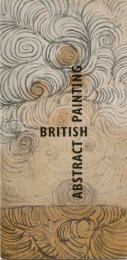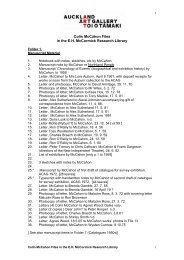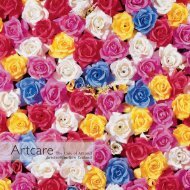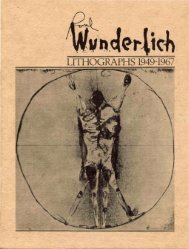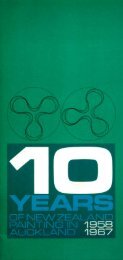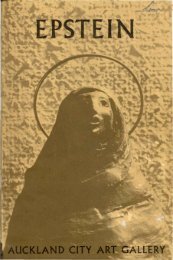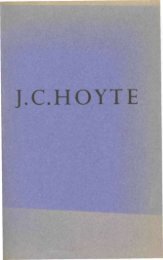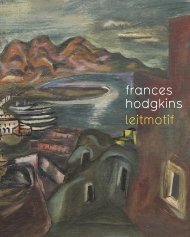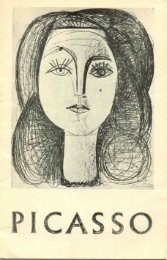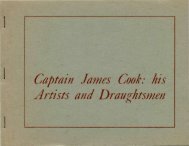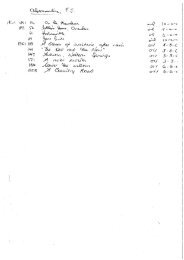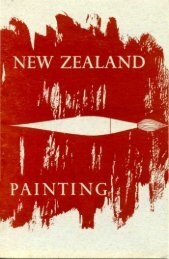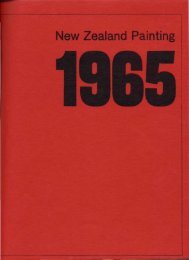EIGHT NEW ZEALAND ARTISTS - Auckland Art Gallery
EIGHT NEW ZEALAND ARTISTS - Auckland Art Gallery
EIGHT NEW ZEALAND ARTISTS - Auckland Art Gallery
- No tags were found...
Create successful ePaper yourself
Turn your PDF publications into a flip-book with our unique Google optimized e-Paper software.
This exhibition has been made possible by the generosity and co-operation of the Director and Trustees of theNational <strong>Gallery</strong> of Victoria and the New Zealand Department of External Affairs. The catalogue has been donatedby Wakefield Press I id. Mil Photoengraving Ltd, Birch Rising Photography. Wiggins Teape Overseas Sales Ltd. (i.K.DenticeIn a recent review of a New Zealand exhibition in London, the critic. Robert Wraight. remarked that before seeingthe works he had half expected to find something akin to Australian painting. His assumption was reasonableenough, it seems logical to expect two countries of almost identical origins, separated by a mere 1,400 miles ofwater and facing mutual problems as the only European nations in a predominantly non-European area, to hsome common characteristics of expression. It is a fact, however, that the cultural gap existing between New Zealandand Australia is far greater than that between either country and Europe. It is curious to note that the two countrieswere a great deal closer, culturally speaking, in the nineteenth century than they have ever been since; influentialfigures of that period are shared by both countries, Augustus liarle. William Strutt and Girolamo Nerli forinstance. By the turn of the century, however, the traffic is one way; indeed some quite notable Australian paintersare in fact, expatriate New Zealanders.Since its post-war flowering. Australian painting has become quite well known in this country. It is a sadcommentary on the inherent cultural pessimism of New Zealanders that, in some parts of the country at least,Australian painting is a great deal better known than New Zealand painting. The internal isolation of centres ofpopulation is perhaps a greater cultural problem here than the well remarked, if ficticious, isolation fromEuropean civilisation and enlightenment.New Zealanders have begun to look towards Australia, initially perhaps with envy, for the rosy glow of the artboom across the Tasman has made this country seem, for artists at least, something of a wasteland. It is important,however, that Australia also knows something of us. is aware of New Zealand's cultural identity, for events arebeginning to prove the desperate necessity of mutual understanding. As somebody put it. the legions have returnedto Rome, for the future our most urgent problems are likely to be shared.Consequently the co-operation and generosity of Mr Eric Westbrook in making this exhibition possible is doublyimportant, it has not only supplied the artists involved with an opportunity to exhibit in Australia, it could alsomark the end of more than a generation of isolation.It is to be hoped that this particular exhibition will be the beginning of a greater exchange of work between the twocounties. The scope of the collection is limited, representing only eight artists from the <strong>Auckland</strong> area, but itshould seise as an adequate introduction to contemporary New Zealand painting.The most enduring image in New Zealand painting has been that of the landscape. Unlike Australia, the landscapehere is not positively menacing, it does not offer any marked physical challenge, no deserts, venemous reptiles orvast unexplored wastelands. Certainly, in the South, there are large areas of unexplored forests, but in general thelandscape is passive, even indifferent. Possibly this very indifference might supply the reason for some 150 years ofobsession. Or more simply the landscape may occupy the central place merely by default, for there has certainlybeen little else to occupy the artist, or else whatever there was. the Maori Wars, the hardships of colonial life,occupied him in a far more direct seiWhatever the reason, the bulk of painting here has been landscape orientated; in the 90's Petrus van der Veklencould project into the wild landscape of the Otira Gorge, the romantic expressionist themes which in his nativeHolland had been reflected in the realities of peasant life, while in the 40's Colin McCahon struggled to set thePassion in the hills and plains of Canterbury and Nelson and later used landscape elements to represent thePassion itself. Since 1958, however, the emphasis has shifted and contemporary painting has increasingly involveditself with more urban themes. Some of these new developments are represented in this exhibition.The change ha :bout for a number of reasons, but perhaps among the most significant is the changingattitude of the New Zealanders themselves. They have begun to feel, at last, some kind of identity; the idea that theirexistence in these Islands is part of an unfair plot to deprive them of the cultural goodies of Europe, is no longercurrent. It has become more generally recognised that this painting is all we have, all that speaks to us directly,that might arrive at the Universal through our own particular. The imported vardstick now seems less relevant; andonce belief is offered, <strong>Art</strong> must flourish.HAMISH KEITH



